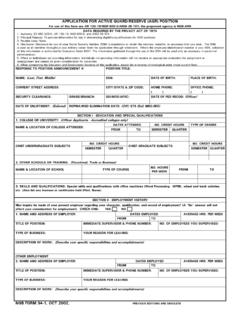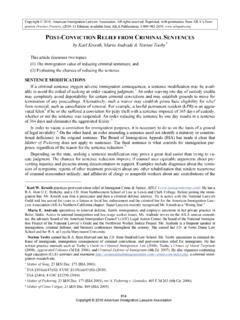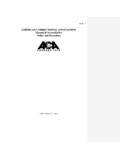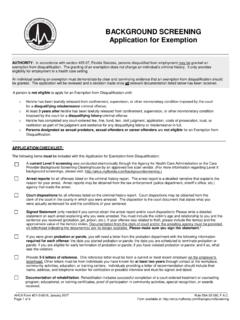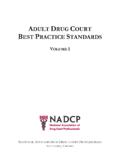Transcription of LIFE WITHOUT PAROLE - The Real Cost of Prisons …
1 I Criminal Justice Policy Coalition Norfolk Lifers Group life WITHOUT PAROLE A Reconsideration Gordon Haas and Lloyd Fillion Collective Action for Humane, Healing and Effective Criminal Justice Policy ii Acknowledgments This paper is an outgrowth of a policy opposing life WITHOUT PAROLE , adopted in 2003 by the Criminal Justice Policy Coalition. The first paragraph of the two-page policy (found at ) reads: The Board of the Criminal Justice Policy Coalition, after several years consideration, is endorsing life With the Possibility of PAROLE after 25 Years (LWPPA25) as the appropriate maximum sentence to be given to those convicted of any crime, including first-degree murder. Currently the Commonwealth imposes the sentence of life WITHOUT PAROLE (LWOP) as the maximum sentence for those convicted of first-degree murder. The CJPC opposes LWOP as it does the Death Penalty, viewing both sentences as antithetical to a criminal justice policy based on restorative principles.
2 (adopted May 23, 2003) Consideration of this punishment certainly did not begin with that policy on that date. There are many individuals within the Commonwealth who individually concur that the maximum sentence of natural life is wrongheaded; those individuals are found within the legal profession and among criminologists as well as among the general citizenry. This paper intends to expand upon that policy and perhaps provide a vehicle for discussion and reconsideration. There are a number of individuals who gave valuable comments and guidance to this paper: board members of the two sponsoring organizations, in particular the late Peg Erlanger, John Currie, Eric Tennen, Dr. Jenifer Drew and Dirk Greineder. In addition, staff of The Sentencing Project in Washington, provided critical guidance and input: Marc Mauer, Executive Director, Dr. Ashley Nellis, Research Analyst, and Nicole Porter, State Advocacy Coordinator.
3 Research Analyst Stephanie Geary and Director of Information Technology David Quinlan of the MA Board of PAROLE graciously extended great assistance in compiling and providing certain statistics on paroled lifers in the Commonwealth. The government documents staff of the Boston Public Library was always generous with their assistance in providing court cases and state documents. Tom Neumeier and David Jefferson provided invaluable help with overcoming computer glitches and layout. To all these individuals the authors are indebted. Of course, any errors are the responsibility of the authors alone. iii About the Authors Gordon Haas has served as chair of the Norfolk Lifers Group at MCI-Norfolk for a number of years. In addition to this project, he is the author of an annual publication A Study of PAROLE Board Decisions for Lifers in 2009 (April, 2010) now in its 4th edition and available from The Norfolk Lifers Group, Box 43, Norfolk, MA 02056-0043.
4 (Lifers Group Inc. Box 269, No. Quincy, MA 02171, $ to cover postage and handling). Lloyd Fillion is a former board member of the Criminal Justice Policy Coalition and of the Massachusetts Citizens Against the Death Penalty. His background includes several decades of work with the former National Committee Against Repressive Legislation, a civil liberties organization focused on first amendment freedom of speech issues. He has written analyses of the several Geoghan reports as well as of several other CJ reports issued by the Commonwealth. About the Organizations The Criminal Justice Policy Coalition, established in 1996, is a member-based, non-profit organization dedicated to the advancement of effective, just, and humane criminal justice policy in Massachusetts. It seeks to accomplish this by expanding the public discourse on criminal justice, promoting dialogue and cooperation among diverse stakeholders, and building support for policies that better protect our communities, promote accountability and change for offenders, and provide restitution to victims.
5 It holds occasional networking meetings on a variety of criminal justice issues, sponsors public forums and conferences, organizes legislative action, and provides support and coordination to groups engaged in advocacy. CJPC advocates the adoption of evidence based practices in sentencing, incarceration, probation and PAROLE to implement practices which are proven to reduce recidivism and focus scarce resources on those most in need of supervision and support. Since its founding in 1974, the Norfolk Lifers Group (MCI-Norfolk, Box 43, Norfolk, MA 02056-0043) has been continuously active in efforts directed at reforming penal and rehabilitative programs with the goal of reducing recidivism. It provides education programs for all inmates geared toward peace building and reconciliation, institutes programs for strengthening family ties, provides help to prisoners with medical issues, and hosts seminars regarding current legislative efforts impacting public safety.
6 It also assists long-term prisoners with their preparation for PAROLE hearings. The Lifers Group had constructed hundreds of wooden toys for the Toys for Tots program, established a Reading for the Blind Program, and hosted fund raising races for local charities until all such programs were eliminated by the Weld administration under its getting-tough-on-crime and returning prisoners to the joys-of-breaking-rocks philosophy. iv Dedication This work is dedicated to the late Peg Erlanger. Peg was a member of the CJPC board for the better part of the first decade of this century. In addition, she was intimately involved with the Alternatives to Violence Project at the national and international levels. Peg was firmly convinced of the need to eliminate life WITHOUT PAROLE and helped guide this project through many phone calls and emails with one of the authors, as well as using her position as CJPC chair to ensure that the organization remained supportive.
7 Her dedication to moving beyond retributive justice provides continued inspiration for the board. v PREFACE In Massachusetts, the maximum penalty for murder is life in prison WITHOUT the possibility of a PAROLE (hereinafter LWOP). Often, when murder is discussed, the most heinous or bizarre murders take center stage, as if their perpetrators, the Charles Mansons* or Ted Bundys**, are representative of all those serving life sentences. The nearly one thousand men and women serving LWOP in Massachusetts, however, include those who were juveniles at the time of the murder, those who participated in a joint enterprise in which another person committed the actual murder, as well as some who have served decades in prison and who no longer pose a threat to society by reason of rehabilitation and/or age. A considerable number of these thousand individuals both recognize and are repentant of the suffering they have caused, and have done the difficult work needed to transform themselves into, and become agents of, constructive change for others.
8 There should be no gainsaying that any killing of a human being is horrendous.** As with all killing, murder, the unlawful taking of a life , sows pain and suffering much beyond the immediate victim or victims. A murder rips through, and often rips apart, close families and friends of the victim, and most often does the same to the murderer s family and friends. Murders also impact less close associates of the victim and of the offender as well; murder destroys a part of the social fabric of the broader community. It is impossible to deny these impacts. Nothing can absolve the murderer of the responsibility for the consequences of this act, as nothing can reverse that loss of life . All *Charles Manson was the leader of a cult, which brutally murdered 7 persons over a two night period at two residences in greater Los Angeles in 1969.
9 While technically eligible for PAROLE , Manson has been denied each time he has appeared before the California PAROLE Board. ; accessed ** Ted Bundy was a serial killer who is thought to have murdered at least 30 women over the course of 5 years between 1974 and 1978. ; accessed ** Assisted suicides- occasionally called mercy killings - are exempted from this statement; they have a unique complexity and are well outside the considerations of this paper. vi affected survivors are forced to come to terms with the murder, its consequences, and suffer the voids which murder creates. This process can take years, often a lifetime. That said, life is not frozen at the point of a murder. People move on, struggling to self-mend, perhaps even those who perceive themselves as to be frozen by that act. The community is better served by recognizing that movement and embracing such healing in perpetrators and their families and friends as it intends to do in the families, friends and associates of the victims.
10 It is in that healing that the community s social fabric can be rewoven. There is substantive literature* addressing the devastation of murder and the impact on survivors. This paper only intends to address one aspect immediately impacting certain individuals the murderers as well as the community, which aspect has not received such attention: the punishment of life - WITHOUT - PAROLE . This paper argues for the introduction of a PAROLE hearing after twenty-five years of incarceration for those sentenced to LWOP as a way to recognize the healing which can occur in all people, even those who have committed murder. * In addition to the scholarly sources of analyses regarding this work of healing are first person accounts, several of which are listed in the bibliography of the website for Murder Victims Families for Human Rights ( ~ ; accessed ) 1 PART 1: INTRODUCTION Everyone serving a life WITHOUT PAROLE sentence in Massachusetts, after twenty-five years should be afforded an opportunity to demonstrate both a rehabilitated character and a low public safety risk through access to a PAROLE hearing and, where appropriate, PAROLE .


